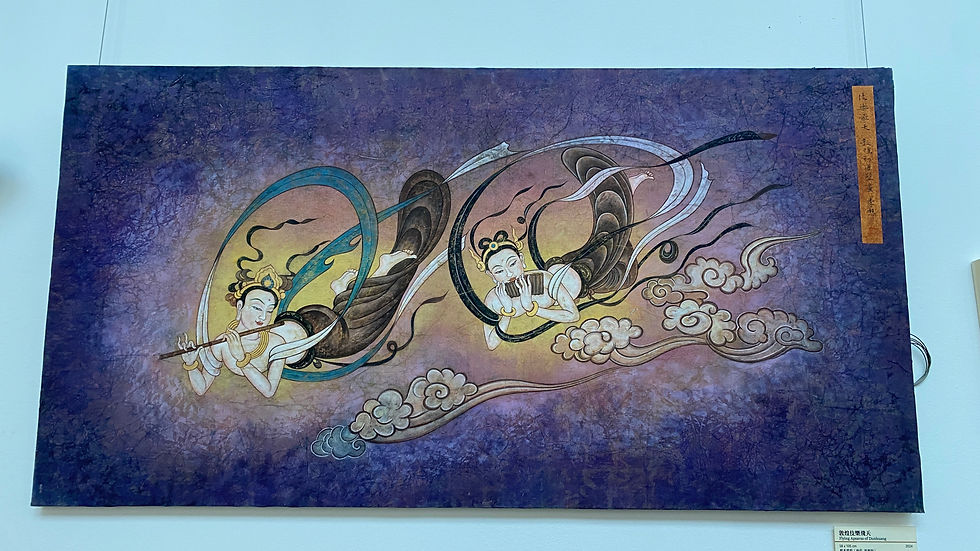"Inner Reflections on the Path of Purity" Art Exhibition Opens at Fo Guang Shan Buddhist Temple, North Carolina: A Fusion of Art and Faith
- Apr 25
- 4 min read
[Reported by Xinyu, North Carolina, USA]

The opening ceremony of "Inner Reflections on the Path of Purity: Chinese Buddhist Art Through the Brush of Xiang Li" was held at Fo Guang Shan Buddhist Temple, North Carolina on February 2,2025, with approximately 60 attendees. The exhibition features over 50 artworks by artist Xiang Li, including reproductions of Dunhuang murals and Yongle Temple meticulous mural paintings. Many of the pieces depict Buddhist bodhisattvas and celestial beings, blending traditional and contemporary artistry to bring a fresh perspective to Buddhist art.

Xiang Li, a member of the Chinese Female Artists Association and a specially appointed painter at the Nanjing Academy of Painting and Calligraphy, currently resides in North Carolina, USA. In 2019, she participated in the National Arts Fund project for the preservation and restoration of Tang Dynasty murals. She explained that "Inner Reflections on the Path of Purity" symbolizes the spiritual states one experiences on the journey toward purity and enlightenment in Buddhism—emotions like doubt, determination, joy, and affliction. These inner reflections are key manifestations of a practitioner’s path. Through self-awareness and contemplation, practitioners can better align themselves with the path to awakening.

At the opening ceremony, Venerable Miao Jou, the superintendent of Fo Guang Shan Buddhist Temple, North Carolina, elaborated on the origins of illustration paintings (Jingbian paintings) and shared Venerable Master Hsing Yun’s vision for "The Next 50 Years of Fo Guang Shan," which emphasizes promoting Buddhism through the arts. Since his early years, Venerable Master Hsing Yun dedicated himself to preserving and exhibiting Buddhist cultural relics. What started as a simple display in a classroom has grown into 27 Fo Guang Yuan Art Galleries worldwide, fostering the integration of Buddhism and artistic culture. Although Fo Guang Shan Buddhist Temple, North Carolina is not of museum-grade specifications, it has transformed its cultural corridor into an exhibition space to introduce Buddhist art to the local community. Through the display of sacred bodhisattva images and celestial offering paintings, the exhibition aims to inspire visitors with the compassion of bodhisattvas and the devotion of celestial beings, deepening their faith and awakening deeper kindness and wisdom within.

During her guided tour, Xiang Li shared that the exhibition is structured around three artistic approaches: original mural reproductions, restoration copies, and contemporary reinterpretations. She employs mineral pigments such as azurite, turquoise, red coral, and cinnabar, along with a Dunhuang sand-based foundation to replicate the texture of ancient cave murals. Since 2007, she has been painting bodhisattvas, and many have noted that her own demeanor has become more compassionate over the years. She attributes this change to the deep reverence she feels while painting, hoping to convey Buddhist teachings and joy through her creations.

Regarding her series of 100 Flying Apsaras paintings, Xiang Li noted that the imagery of apsaras in Dunhuang murals has evolved over time, reflecting different artistic styles and aesthetic preferences across historical periods. Through careful study and comparison, she incorporates modern artistic techniques to reinterpret these celestial figures, giving new life to this ancient art form from a contemporary perspective.
"Having the opportunity to hold a solo exhibition at Fo Guang Shan Buddhist Temple, North Carolina, showcasing works related to Dunhuang murals and Chinese Buddhist paintings, is deeply meaningful to me," Xiang Li joyfully shared. From a cultural perspective, Chinese paintings and Dunhuang murals carry thousands of years of rich Chinese heritage and are treasures of Eastern aesthetics. She hopes to introduce the local community to the unique beauty of Chinese art. In terms of artistic exchange, she aims to share the expressive brushwork of Chinese painting and her interpretation of Dunhuang murals' colors, lines, and forms with American audiences. On a spiritual level, Buddhist paintings embody profound cultural significance, symbolizing compassion, wisdom, and tranquility.

Displaying her work at Fo Guang Shan Buddhist Temple, North Carolina allows visitors to immerse themselves in both art and the temple's serene, sacred atmosphere, offering spiritual inspiration and a sense of timeless connection. She hopes that her paintings bring joy and resonance to viewers, awakening hearts through the fusion of art and faith.

The exhibition, which opened on January 29, will run for a full year, inviting the public to experience Xiang Li’s artistic expression of truth, goodness, and beauty. Additionally, Xiang Li will be leading a "Flowers and Birds of the Song Dynasty" meticulous painting class at Fo Guang Shan Buddhist Temple, North Carolina, starting on February 11. (Online registration available at: https://shorturl.at/d2hBn).







